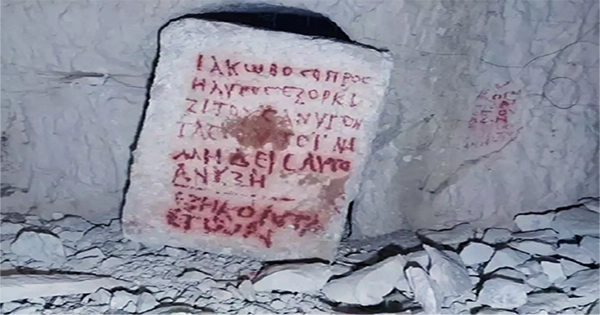If there’s one thing you don’t want to find in a grave you just opened, it’s a strange and ominous, message written in what appears to be blood, declaring that anybody who opens the grave will be cursed.
But that’s exactly what was discovered in Galilee, an area spanning northern Israel and southern Lebanon, last year. Excavating the UNESCO World Heritage Site Beit She’arim Necropolis, archaeologists found a 1,800-year-old grave marker for a Jewish convert named Jacob – and he was not happy about it.

“Iokobos [Jacob] the proselyte swears upon himself that any who open this grave will be cursed,” reads the stone marker. It’s an “odd” message, written by Jacob himself in idiosyncratic Greek, according to Tel Aviv University Professor Jonathan Price, who translated the tablet: “That’s how he spoke, apparently,” he told The Times of Israel.
The stone slab includes eight lines, ending with the words: Yaakov Ha’Ger vows to curse anybody who would open this grave, so nobody will open it. 60 years old.” It’s thought the 60, which was written in a different script, was added by somebody else and perhaps refers to his age.
.jpg)
This is the first tomb marker found at the site to explicitly confirm the buried was a convert to Judaism. Image credit: Evgeny Ostrovsky, Israel Antiquities Authority.
The discovery was presented at the Northern Conference, held jointly by the University of Haifa and the northern region of the Israel Antiquities Authority (IAA) on June 1.
Somewhat reassuringly, and despite appearances, the message is written not in blood but scarlet paint – though that certainly doesn’t take away from the spooky effect. It’s one of the first two inscriptions to be discovered at Beit She’arim in the past 65 years, and the only grave marker out of more than 300 found at the site to unequivocally refer to the buried as a convert.
“The inscription is from the Late Roman or Early Byzantine period, in which Christianity was strengthened. And here we find evidence that there are still people who choose to join the Jewish people,” said Prof. Adi Erlich of the Zinman Institute of Archaeology and the University of Haifa’s School of Archaeology who heads the excavations at Beit She’arim, in a statement sent to IFLScience.
And we know that Yaakov Ha’Ger, as his chosen name would have been in Hebrew, was a “full convert” to Judaism, because the grave marker uses the Greek word “proselyte,” explained Price. This contrasts with another type of Jewish adherent of the time, the “God fearer,” he told The Times of Israel, who would likely not follow all Jewish commandments.
But despite learning these personal details of his life, there are some surprisingly basic things we don’t know about Jacob – and perhaps we never will.
“Beit She’arim is known for being an international burial ground for Jews from all over the east,” Price told The Times of Israel. That makes it basically impossible to know where he came from originally – “unless we find his diary, which we won’t,” Price said.
And perhaps strangest of all: we don’t even know where he is now. The grave marker wasn’t found at Jacob’s tomb, but propped up against a wall in a previously undiscovered cave.
Well – undiscovered by archaeologists, that is. The reason for the marker’s unexpected location was almost certainly grave looters, Price told the Times of Israel, making it highly unlikely that Jacob’s grave will be definitively identified in future.
In other words: future excavators, watch your back – because the next unmarked tomb you open might be Jacob’s. And he will be livid.








